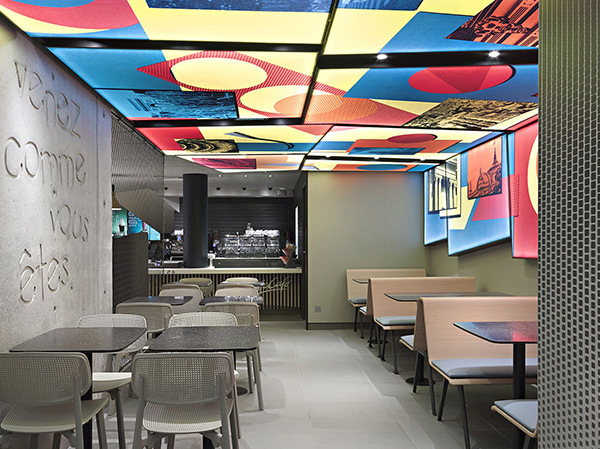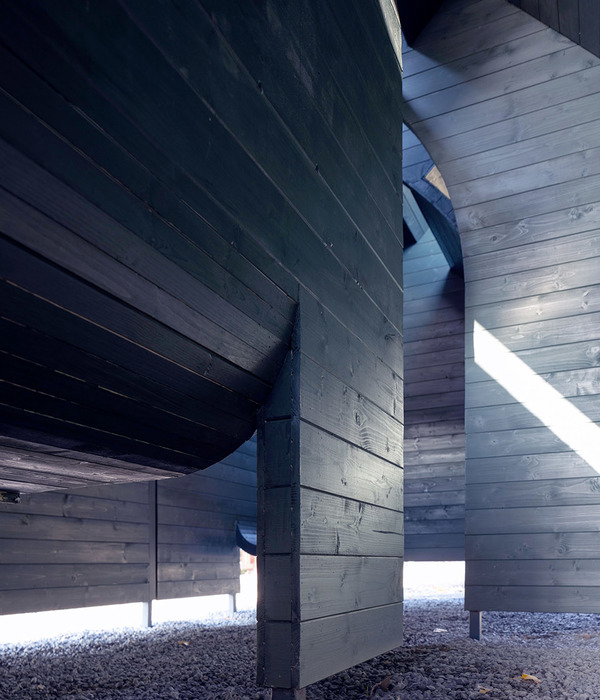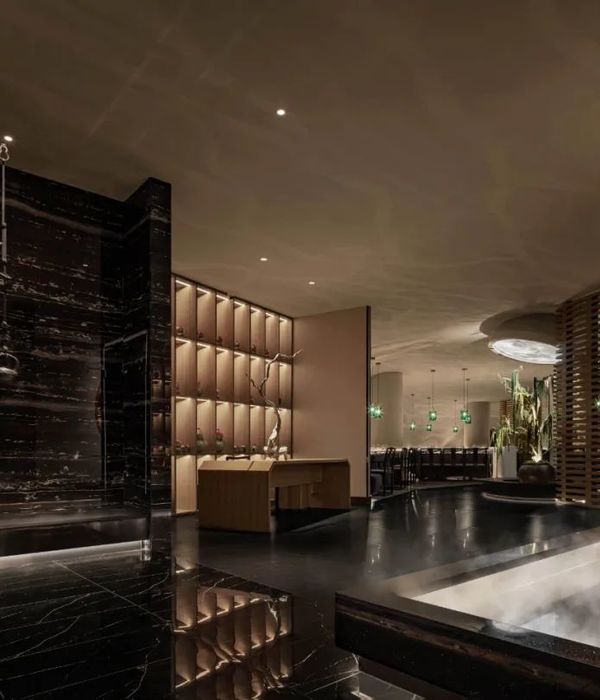被唤醒的记忆-悠然山居 Wakened memory – Leisurely Mountain Life
九华山是中国佛教四大名山之一,山上风景优美、空气新鲜,每年上山的游客量非常大,是一个典型的全国目的地风景旅游区。项目位于九华山核心风景区塔院旁,整个地形是一个山谷盆地,水塘,竹林,古树,水杉以自然的势态生长。
Jiuhua Mountain is one of the four famous Buddhist mountains in China, with beautiful scenery and fresh air, and a large number of tourists every year, which is a typical national destination resort district. The project is located near the tower courtyard, the core scenic spot of Jiuhua Mountain. The whole terrain is a valley basin, with pond, bamboo forest, ancient trees and metassequoia growing in a natural state.
▼项目概览,project overview ©陈铭
设计的开始 Original intention of the design
项目前身是一个只有旅游旺季才有客源的普通经济型旅馆,这是当时山上所有经济型酒店的常态。项目方期望以设计为驱动力,做一个目的地度假型精品民宿。我们希望从重拾日常的生活美开始,呈现一种从形式到空间均可被感知的设计力。Edward Hopper曾说“在日常的平凡事物中有一种力量,只有当我们注视良久时,才能发现它。”
The predecessor of the project was an ordinary budget hotel with only tourists in the peak season, which was the norm of all budget hotels on the mountain at that time. The project side expects to make a destination resort boutique homestay driven by design. We hope to start from the regain of the beauty of daily life, to present a design capability able to be perceived from form to space. Edward Hopper once said, “there is a power in the routine ordinary things, which can be found only when we look long enough for it.”
▼酒店夜间立面,facade view by night ©陈铭
内在的张力 Internal tension
通过接待室、客房、餐厅三种形态,建筑的整体组合成其功能属性。进入酒店的路线被现场条件所限定,因此我们挖掘出一个可以做具叙事性入住体验的机会,从停车场、石阶、树林、茶园、石板路、水塘这一路所引发的好奇心,在最终接触空间时会得到满足。
▼平面图,plan ©门觉建筑
▼场地剖面图,site section ©门觉建筑
▼走廊,corridor ©陈铭
进入客房后,内部垂直的方向被设计成两个空间: 水平方向由功能限定出两个体块,产生了一个具有张力的内部形态;茶室,休闲区、洗漱区,卧室区,打坐区生成场域。当漫游在这些空间时,走向地面,踏上台阶,爬上楼梯,依靠在沙发旁,抬头望向玻璃外的景色,打开旁边的木窗,坐下或站立从而产生亲密接触,在停下的瞬间,内部呈现出一种强烈的情感氛围。
▼客房剖面透视图,guest room sectional perspective ©门觉建筑
▼客房概览, guest room interior view ©陈铭
▼客厅,living room ©陈铭
▼具有张力的内部形态,an inner form with tension ©陈铭
▼从茶室区通往卧室,way to the bedroom area from the tea room ©陈铭
▼二层的卧室区域,the bedroom area on the mezzanine ©陈铭
▼卧室窗景,bedroom view ©陈铭
▼卧室细部,bedroom detailed view ©陈铭
潜在的原生力量 The underlying archaic power
设计是一种创造行为。我们希望在每个细节上都可以找到一种全新的方法。在选择物料时,希望建筑可以回应外界,去呈现一种特定的功能,可以见证过去生活的真实,吸纳生活的痕迹。走入客房一层的茶室区,内部被木饰面所包裹,保留了一片玻璃作为内外接触的媒介。当脚踏上榻榻米,盘腿坐在蒲团上,烧水煮茶,景色、阳光、露水,尽在眼前,推开窗,微风习习,我们所期待的空间感知已呈现出来。如今,这里已然成为客人入住最喜欢呆的地方。建筑的立面语言用的是水泥的体块,遗存的民居陶瓦,夯土和青竹的日常材料。我们挑选荒石料作为踏步石,耐火砖为地面,实木与钢组成的楼梯,铜皮的木门,透明的阳光板,这些材料与形式结合生成一个整体,当身体与这些物料亲密接触时,我们希望客人拥有的是一种可以与当前情境对话的心境和原生力量。
▼客房一层的茶室区成为客人入住最喜欢呆的地方, the tea room area of the guest room has become a favorite place for guests to stay ©陈铭
▼茶室细部,tea room detailed view ©陈铭
▼餐厅,dining area ©陈铭
▼浴室,bathroom ©陈铭
▼玄关和台阶细部,entry way and stairs ©陈铭
▼实木和钢楼梯细部,staircases of solid wood and steel
▼客房入口,guest room entrance ©陈铭
▼庭院景观,landscape ©陈铭
▼屋顶视角,roof top view ©陈铭
▼从河塘望向酒店建筑,view to the building from the pond ©陈铭
{{item.text_origin}}



![[2014] 嘻客町咖啡 贵州凯里店
[2014] 嘻客町咖啡 贵州凯里店](https://public.ff.cn/Uploads/Case/Img/2024-06-20/IZKMIiCRAzlAHBPUscQgcKpTp.jpg-ff_s_1_600_700)








